stop start FORD C MAX 2013 Owner's Guide
[x] Cancel search | Manufacturer: FORD, Model Year: 2013, Model line: C MAX, Model: FORD C MAX 2013Pages: 552, PDF Size: 8.55 MB
Page 217 of 552

3. Locate the brake shift interlock
lever on the passenger side of the
shifter assembly.
4. Apply the brake pedal. Using a
screwdriver (or similar tool),
press and hold the white brake
shift interlock lever forward while
pulling the gearshift lever out of
the P (Park) position and into the
N (Neutral) position.
5. Reinstall the console side panel and attach the fastener.
6. Reinstall the access cover.
7. Apply the brake pedal, start the vehicle and release the parking brake.
See your authorized dealer as soon as possible if this procedure is used.
If Your Vehicle Gets Stuck in Mud or Snow
Note:Do not rock the vehicle if the engine is not at normal operating
temperature or damage to the transmission may occur.
Note:Do not rock the vehicle for more than a minute or damage to the
transmission and tires may occur, or the engine may overheat.
If your vehicle gets stuck in mud or snow, it may be rocked out by
shifting between forward and reverse gears, stopping between shifts in a
steady pattern. Press lightly on the accelerator in each gear.
216Transmission
2013 C-Max Full Hybrid(34h)
Owners Guide gf, 3rd Printing, January 2013
USA(fus)
Page 219 of 552
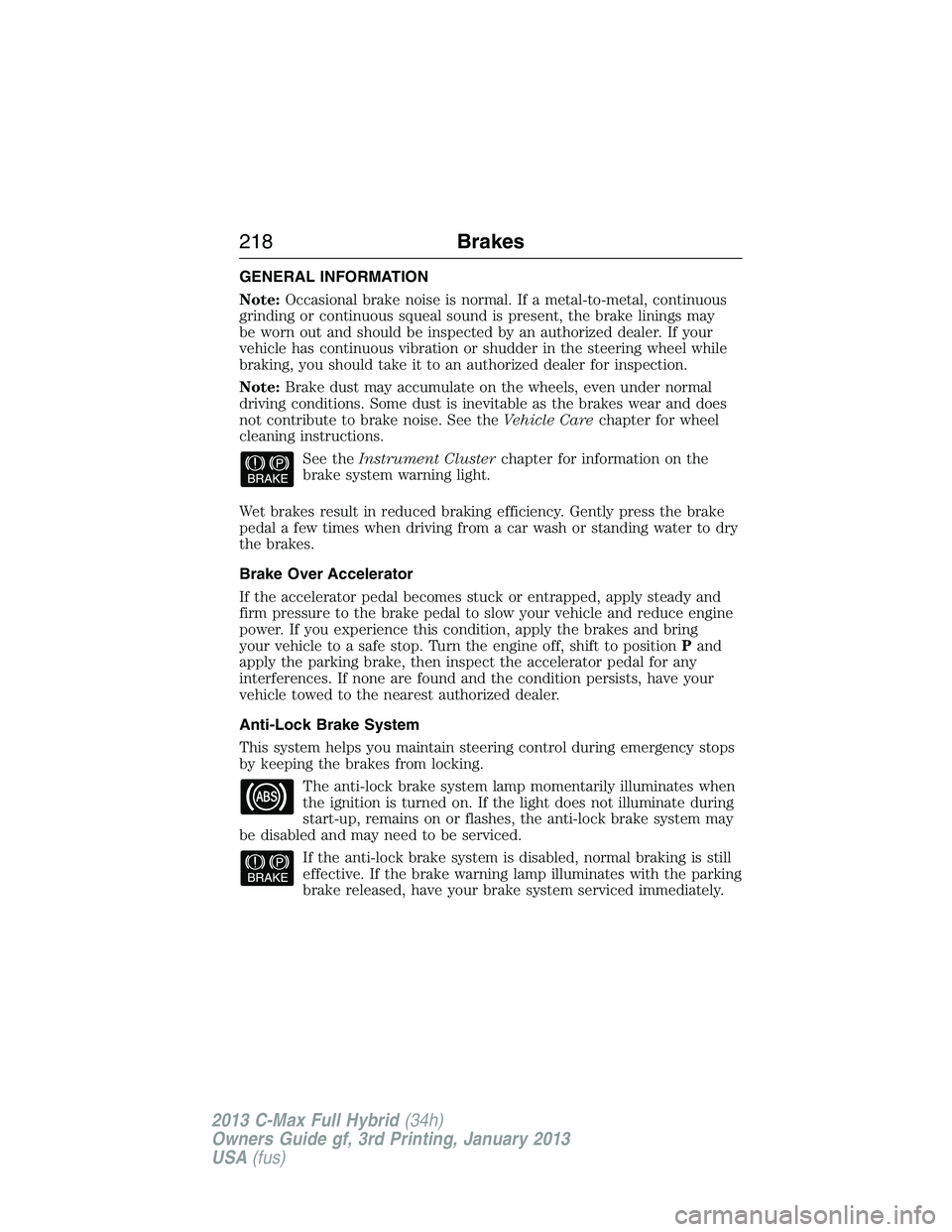
GENERAL INFORMATION
Note:Occasional brake noise is normal. If a metal-to-metal, continuous
grinding or continuous squeal sound is present, the brake linings may
be worn out and should be inspected by an authorized dealer. If your
vehicle has continuous vibration or shudder in the steering wheel while
braking, you should take it to an authorized dealer for inspection.
Note:Brake dust may accumulate on the wheels, even under normal
driving conditions. Some dust is inevitable as the brakes wear and does
not contribute to brake noise. See theVehicle Carechapter for wheel
cleaning instructions.
See theInstrument Clusterchapter for information on the
brake system warning light.
Wet brakes result in reduced braking efficiency. Gently press the brake
pedal a few times when driving from a car wash or standing water to dry
the brakes.
Brake Over Accelerator
If the accelerator pedal becomes stuck or entrapped, apply steady and
firm pressure to the brake pedal to slow your vehicle and reduce engine
power. If you experience this condition, apply the brakes and bring
your vehicle to a safe stop. Turn the engine off, shift to positionPand
apply the parking brake, then inspect the accelerator pedal for any
interferences. If none are found and the condition persists, have your
vehicle towed to the nearest authorized dealer.
Anti-Lock Brake System
This system helps you maintain steering control during emergency stops
by keeping the brakes from locking.
The anti-lock brake system lamp momentarily illuminates when
the ignition is turned on. If the light does not illuminate during
start-up, remains on or flashes, the anti-lock brake system may
be disabled and may need to be serviced.
If the anti-lock brake system is disabled, normal braking is still
effective. If the brake warning lamp illuminates with the parking
brake released, have your brake system serviced immediately.
218Brakes
2013 C-Max Full Hybrid(34h)
Owners Guide gf, 3rd Printing, January 2013
USA(fus)
Page 239 of 552
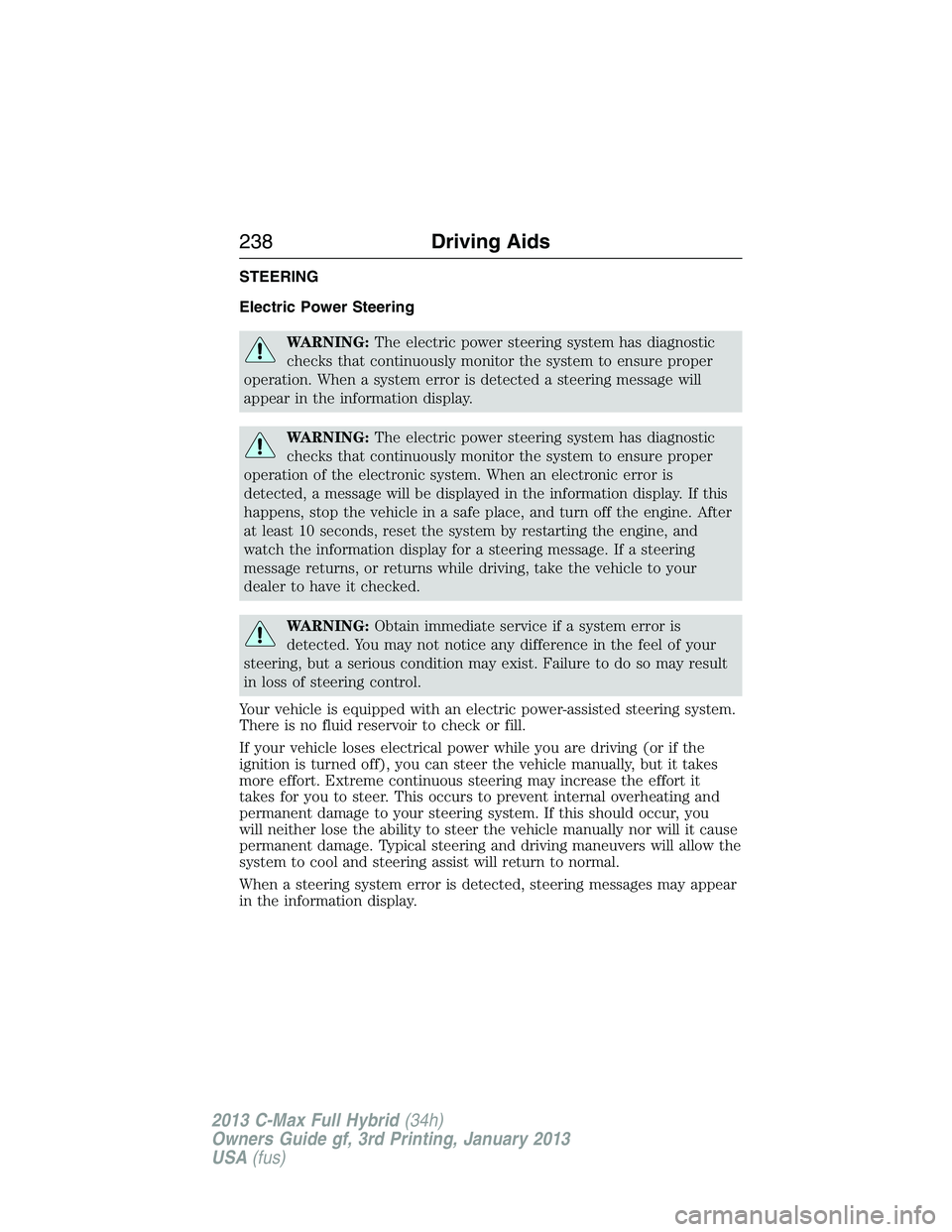
STEERING
Electric Power Steering
WARNING:The electric power steering system has diagnostic
checks that continuously monitor the system to ensure proper
operation. When a system error is detected a steering message will
appear in the information display.
WARNING:The electric power steering system has diagnostic
checks that continuously monitor the system to ensure proper
operation of the electronic system. When an electronic error is
detected, a message will be displayed in the information display. If this
happens, stop the vehicle in a safe place, and turn off the engine. After
at least 10 seconds, reset the system by restarting the engine, and
watch the information display for a steering message. If a steering
message returns, or returns while driving, take the vehicle to your
dealer to have it checked.
WARNING:Obtain immediate service if a system error is
detected. You may not notice any difference in the feel of your
steering, but a serious condition may exist. Failure to do so may result
in loss of steering control.
Your vehicle is equipped with an electric power-assisted steering system.
There is no fluid reservoir to check or fill.
If your vehicle loses electrical power while you are driving (or if the
ignition is turned off), you can steer the vehicle manually, but it takes
more effort. Extreme continuous steering may increase the effort it
takes for you to steer. This occurs to prevent internal overheating and
permanent damage to your steering system. If this should occur, you
will neither lose the ability to steer the vehicle manually nor will it cause
permanent damage. Typical steering and driving maneuvers will allow the
system to cool and steering assist will return to normal.
When a steering system error is detected, steering messages may appear
in the information display.
238Driving Aids
2013 C-Max Full Hybrid(34h)
Owners Guide gf, 3rd Printing, January 2013
USA(fus)
Page 250 of 552
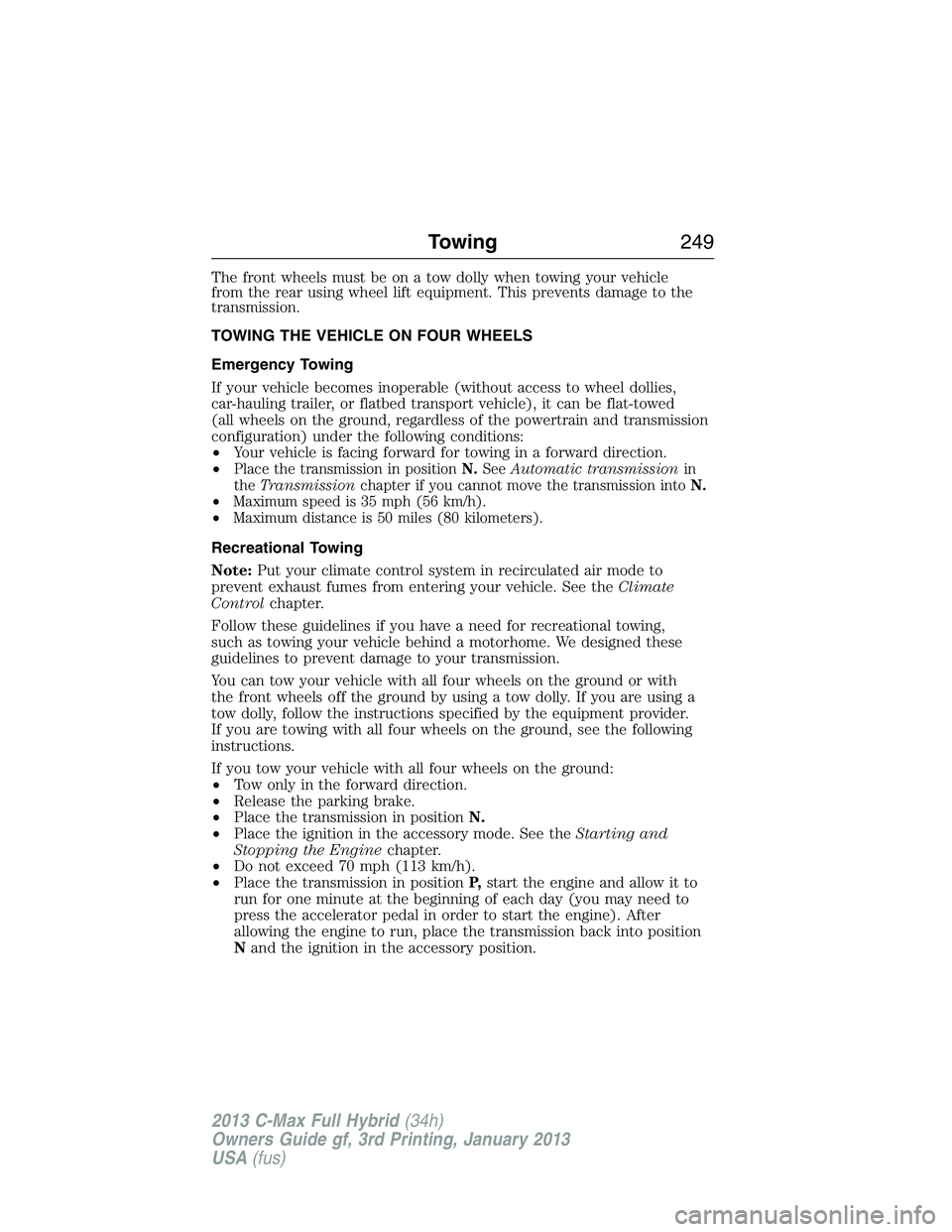
The front wheels must be on a tow dolly when towing your vehicle
from the rear using wheel lift equipment. This prevents damage to the
transmission.
TOWING THE VEHICLE ON FOUR WHEELS
Emergency Towing
If your vehicle becomes inoperable (without access to wheel dollies,
car-hauling trailer, or flatbed transport vehicle), it can be flat-towed
(all wheels on the ground, regardless of the powertrain and transmission
configuration) under the following conditions:
•Your vehicle is facing forward for towing in a forward direction.
•
Place the transmission in positionN.SeeAutomatic transmissionin
theTransmissionchapter if you cannot move the transmission intoN.
•Maximum speed is 35 mph (56 km/h).
•Maximum distance is 50 miles (80 kilometers).
Recreational Towing
Note:Put your climate control system in recirculated air mode to
prevent exhaust fumes from entering your vehicle. See theClimate
Controlchapter.
Follow these guidelines if you have a need for recreational towing,
such as towing your vehicle behind a motorhome. We designed these
guidelines to prevent damage to your transmission.
You can tow your vehicle with all four wheels on the ground or with
the front wheels off the ground by using a tow dolly. If you are using a
tow dolly, follow the instructions specified by the equipment provider.
If you are towing with all four wheels on the ground, see the following
instructions.
If you tow your vehicle with all four wheels on the ground:
•Tow only in the forward direction.
•Release the parking brake.
•Place the transmission in positionN.
•Place the ignition in the accessory mode. See theStarting and
Stopping the Enginechapter.
•Do not exceed 70 mph (113 km/h).
•Place the transmission in positionP,start the engine and allow it to
run for one minute at the beginning of each day (you may need to
press the accelerator pedal in order to start the engine). After
allowing the engine to run, place the transmission back into position
Nand the ignition in the accessory position.
Towing249
2013 C-Max Full Hybrid(34h)
Owners Guide gf, 3rd Printing, January 2013
USA(fus)
Page 259 of 552
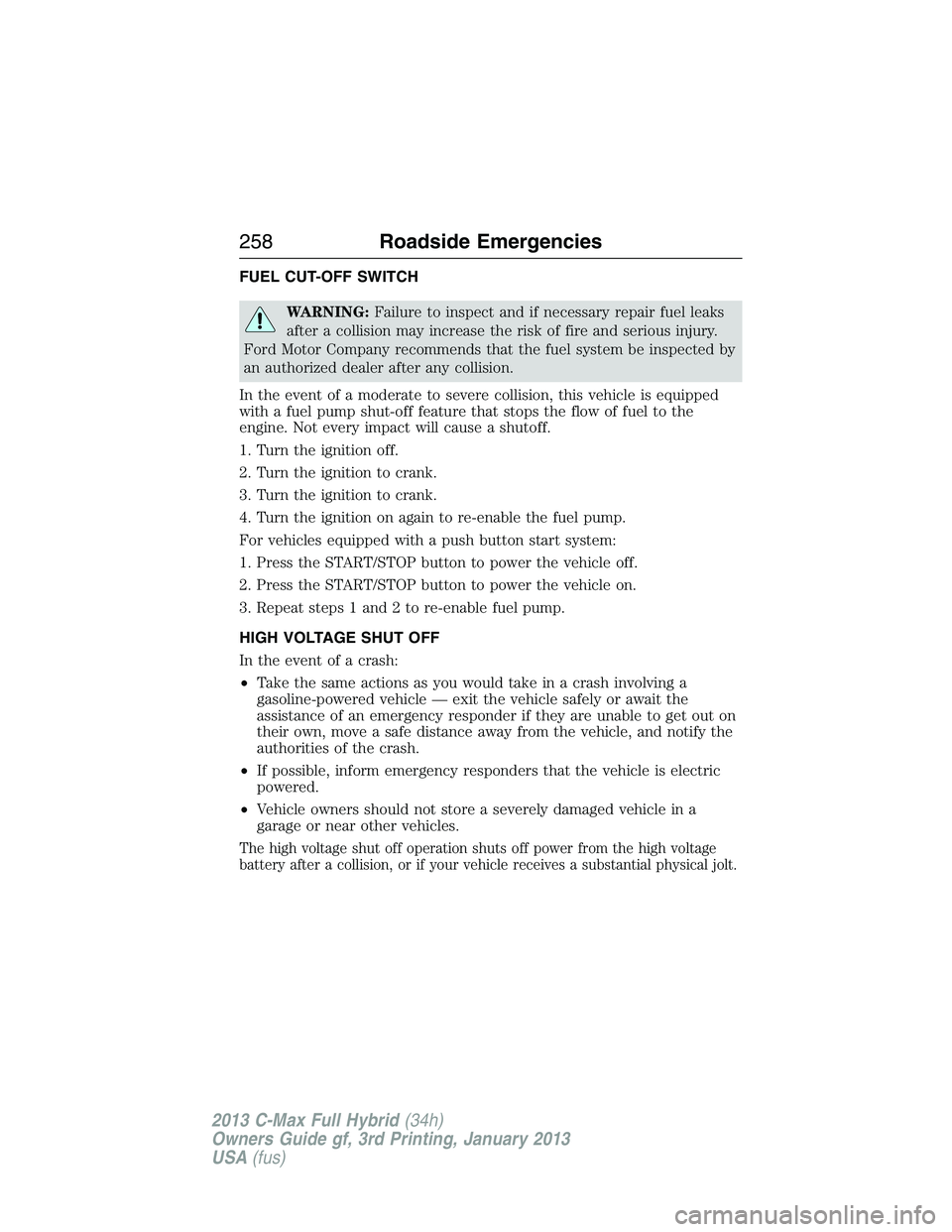
FUEL CUT-OFF SWITCH
WARNING:Failure to inspect and if necessary repair fuel leaks
after a collision may increase the risk of fire and serious injury.
Ford Motor Company recommends that the fuel system be inspected by
an authorized dealer after any collision.
In the event of a moderate to severe collision, this vehicle is equipped
with a fuel pump shut-off feature that stops the flow of fuel to the
engine. Not every impact will cause a shutoff.
1. Turn the ignition off.
2. Turn the ignition to crank.
3. Turn the ignition to crank.
4. Turn the ignition on again to re-enable the fuel pump.
For vehicles equipped with a push button start system:
1. Press the START/STOP button to power the vehicle off.
2. Press the START/STOP button to power the vehicle on.
3. Repeat steps 1 and 2 to re-enable fuel pump.
HIGH VOLTAGE SHUT OFF
In the event of a crash:
•Take the same actions as you would take in a crash involving a
gasoline-powered vehicle — exit the vehicle safely or await the
assistance of an emergency responder if they are unable to get out on
their own, move a safe distance away from the vehicle, and notify the
authorities of the crash.
•If possible, inform emergency responders that the vehicle is electric
powered.
•Vehicle owners should not store a severely damaged vehicle in a
garage or near other vehicles.
The high voltage shut off operation shuts off power from the high voltage
battery after a collision, or if your vehicle receives a substantial physical jolt.
258Roadside Emergencies
2013 C-Max Full Hybrid(34h)
Owners Guide gf, 3rd Printing, January 2013
USA(fus)
Page 260 of 552
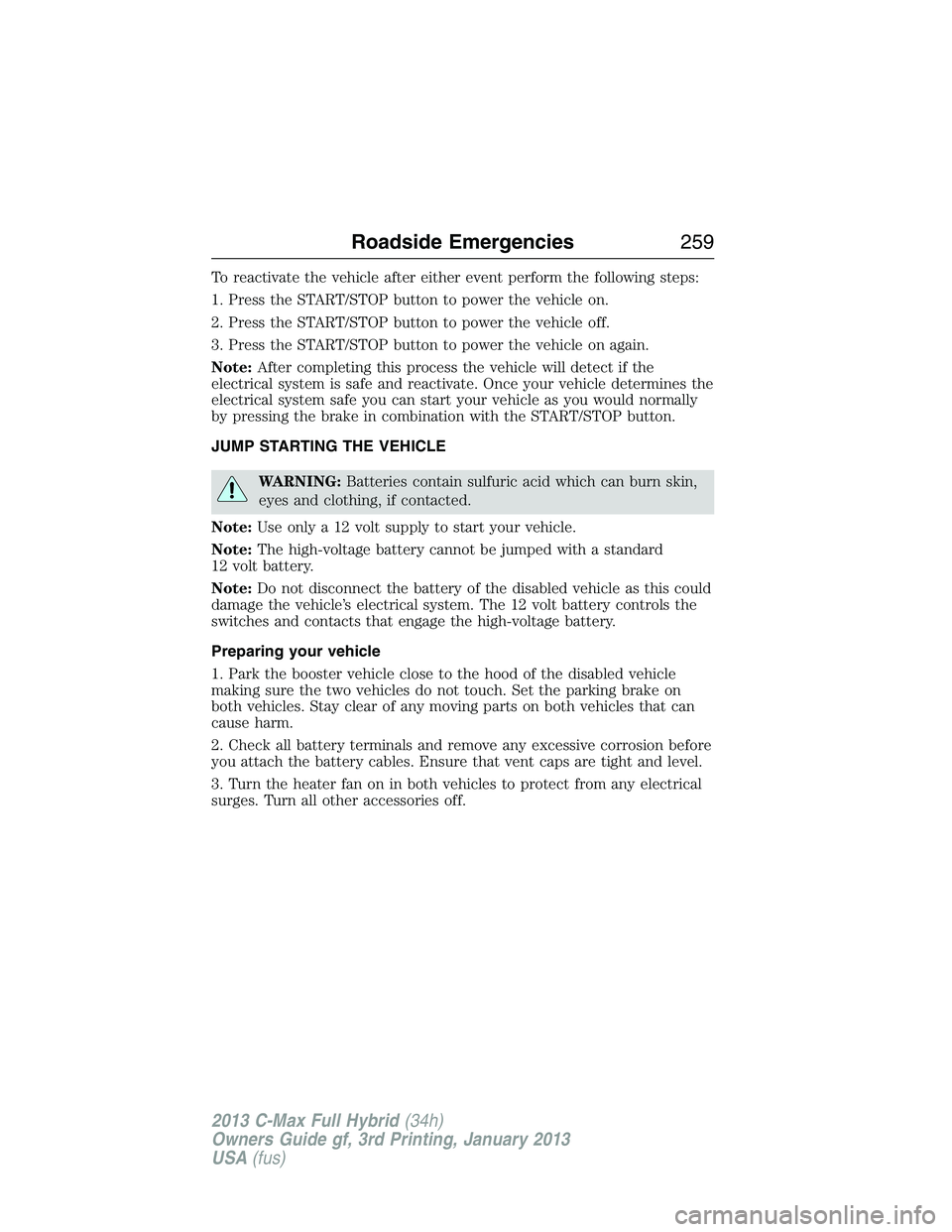
To reactivate the vehicle after either event perform the following steps:
1. Press the START/STOP button to power the vehicle on.
2. Press the START/STOP button to power the vehicle off.
3. Press the START/STOP button to power the vehicle on again.
Note:After completing this process the vehicle will detect if the
electrical system is safe and reactivate. Once your vehicle determines the
electrical system safe you can start your vehicle as you would normally
by pressing the brake in combination with the START/STOP button.
JUMP STARTING THE VEHICLE
WARNING:Batteries contain sulfuric acid which can burn skin,
eyes and clothing, if contacted.
Note:Use only a 12 volt supply to start your vehicle.
Note:The high-voltage battery cannot be jumped with a standard
12 volt battery.
Note:Do not disconnect the battery of the disabled vehicle as this could
damage the vehicle’s electrical system. The 12 volt battery controls the
switches and contacts that engage the high-voltage battery.
Preparing your vehicle
1. Park the booster vehicle close to the hood of the disabled vehicle
making sure the two vehicles do not touch. Set the parking brake on
both vehicles. Stay clear of any moving parts on both vehicles that can
cause harm.
2. Check all battery terminals and remove any excessive corrosion before
you attach the battery cables. Ensure that vent caps are tight and level.
3. Turn the heater fan on in both vehicles to protect from any electrical
surges. Turn all other accessories off.
Roadside Emergencies259
2013 C-Max Full Hybrid(34h)
Owners Guide gf, 3rd Printing, January 2013
USA(fus)
Page 294 of 552
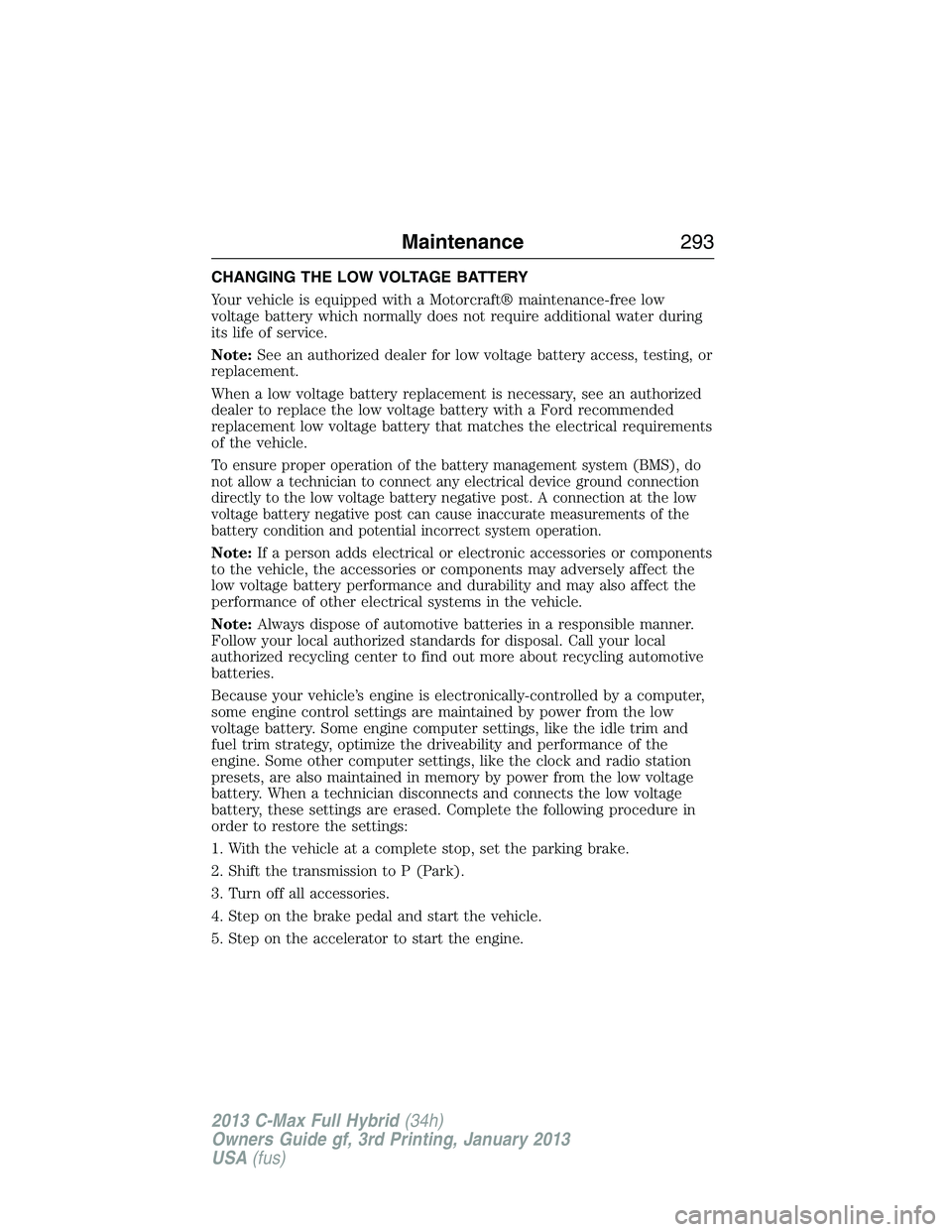
CHANGING THE LOW VOLTAGE BATTERY
Your vehicle is equipped with a Motorcraft® maintenance-free low
voltage battery which normally does not require additional water during
its life of service.
Note:See an authorized dealer for low voltage battery access, testing, or
replacement.
When a low voltage battery replacement is necessary, see an authorized
dealer to replace the low voltage battery with a Ford recommended
replacement low voltage battery that matches the electrical requirements
of the vehicle.
To ensure proper operation of the battery management system (BMS), do
not allow a technician to connect any electrical device ground connection
directly to the low voltage battery negative post. A connection at the low
voltage battery negative post can cause inaccurate measurements of the
battery condition and potential incorrect system operation.
Note:If a person adds electrical or electronic accessories or components
to the vehicle, the accessories or components may adversely affect the
low voltage battery performance and durability and may also affect the
performance of other electrical systems in the vehicle.
Note:Always dispose of automotive batteries in a responsible manner.
Follow your local authorized standards for disposal. Call your local
authorized recycling center to find out more about recycling automotive
batteries.
Because your vehicle’s engine is electronically-controlled by a computer,
some engine control settings are maintained by power from the low
voltage battery. Some engine computer settings, like the idle trim and
fuel trim strategy, optimize the driveability and performance of the
engine. Some other computer settings, like the clock and radio station
presets, are also maintained in memory by power from the low voltage
battery. When a technician disconnects and connects the low voltage
battery, these settings are erased. Complete the following procedure in
order to restore the settings:
1. With the vehicle at a complete stop, set the parking brake.
2. Shift the transmission to P (Park).
3. Turn off all accessories.
4. Step on the brake pedal and start the vehicle.
5. Step on the accelerator to start the engine.
Maintenance293
2013 C-Max Full Hybrid(34h)
Owners Guide gf, 3rd Printing, January 2013
USA(fus)
Page 335 of 552
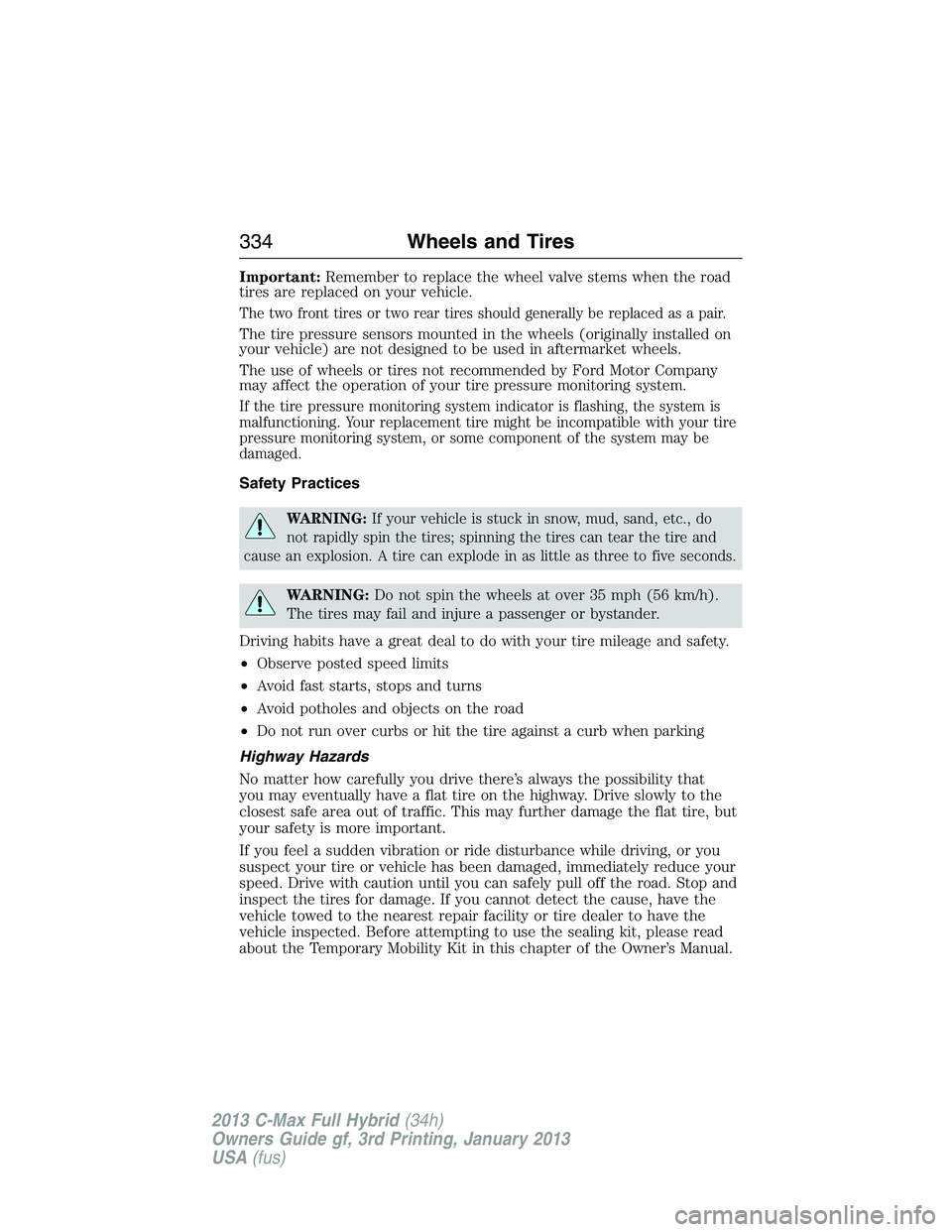
Important:Remember to replace the wheel valve stems when the road
tires are replaced on your vehicle.
The two front tires or two rear tires should generally be replaced as a pair.
The tire pressure sensors mounted in the wheels (originally installed on
your vehicle) are not designed to be used in aftermarket wheels.
The use of wheels or tires not recommended by Ford Motor Company
may affect the operation of your tire pressure monitoring system.
If the tire pressure monitoring system indicator is flashing, the system is
malfunctioning. Your replacement tire might be incompatible with your tire
pressure monitoring system, or some component of the system may be
damaged.
Safety Practices
WARNING:If your vehicle is stuck in snow, mud, sand, etc., do
not rapidly spin the tires; spinning the tires can tear the tire and
cause an explosion. A tire can explode in as little as three to five seconds.
WARNING:Do not spin the wheels at over 35 mph (56 km/h).
The tires may fail and injure a passenger or bystander.
Driving habits have a great deal to do with your tire mileage and safety.
•Observe posted speed limits
•Avoid fast starts, stops and turns
•Avoid potholes and objects on the road
•Do not run over curbs or hit the tire against a curb when parking
Highway Hazards
No matter how carefully you drive there’s always the possibility that
you may eventually have a flat tire on the highway. Drive slowly to the
closest safe area out of traffic. This may further damage the flat tire, but
your safety is more important.
If you feel a sudden vibration or ride disturbance while driving, or you
suspect your tire or vehicle has been damaged, immediately reduce your
speed. Drive with caution until you can safely pull off the road. Stop and
inspect the tires for damage. If you cannot detect the cause, have the
vehicle towed to the nearest repair facility or tire dealer to have the
vehicle inspected. Before attempting to use the sealing kit, please read
about the Temporary Mobility Kit in this chapter of the Owner’s Manual.
334Wheels and Tires
2013 C-Max Full Hybrid(34h)
Owners Guide gf, 3rd Printing, January 2013
USA(fus)
Page 370 of 552
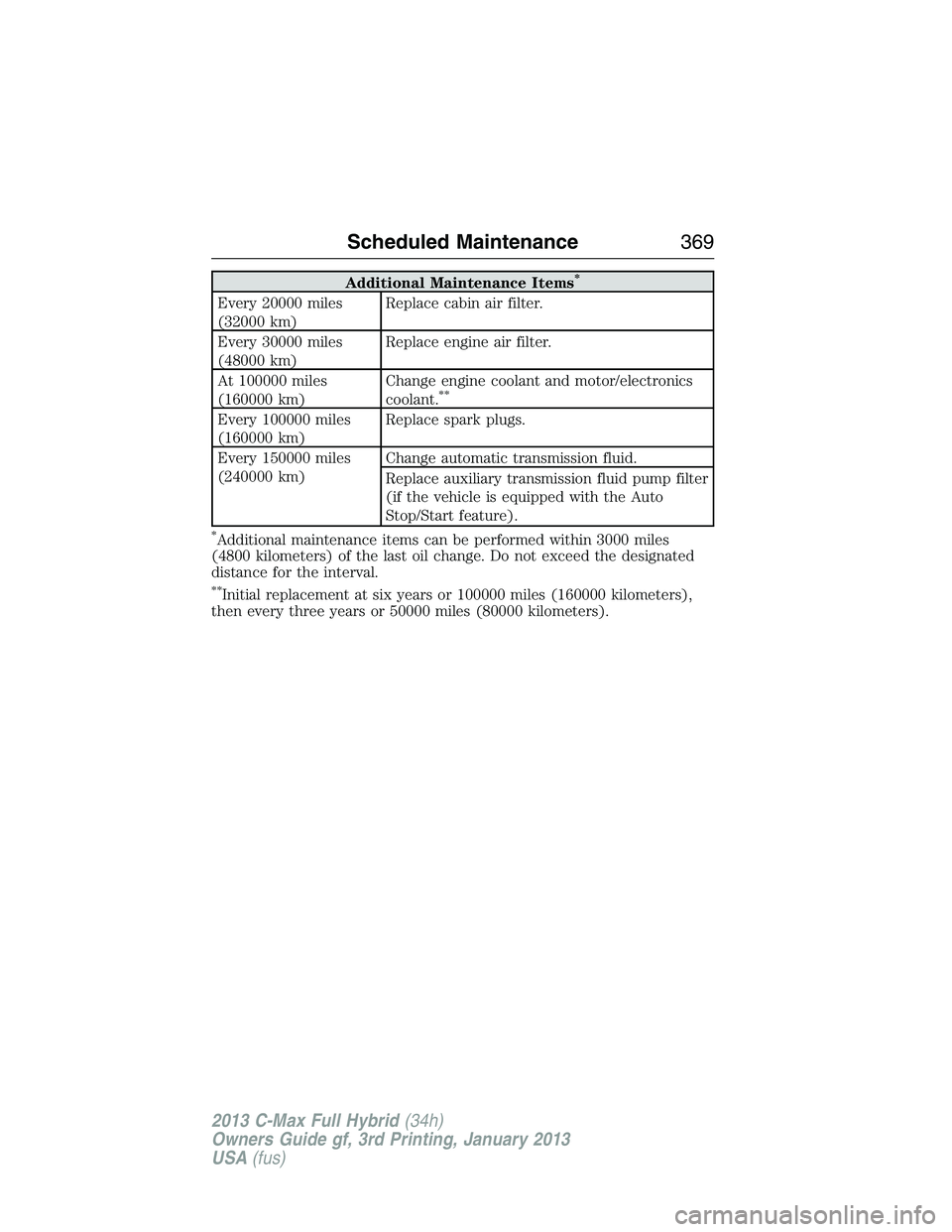
Additional Maintenance Items*
Every 20000 miles
(32000 km)Replace cabin air filter.
Every 30000 miles
(48000 km)Replace engine air filter.
At 100000 miles
(160000 km)Change engine coolant and motor/electronics
coolant.
**
Every 100000 miles
(160000 km)Replace spark plugs.
Every 150000 miles
(240000 km)Change automatic transmission fluid.
Replace auxiliary transmission fluid pump filter
(if the vehicle is equipped with the Auto
Stop/Start feature).
*Additional maintenance items can be performed within 3000 miles
(4800 kilometers) of the last oil change. Do not exceed the designated
distance for the interval.
**Initial replacement at six years or 100000 miles (160000 kilometers),
then every three years or 50000 miles (80000 kilometers).
Scheduled Maintenance369
2013 C-Max Full Hybrid(34h)
Owners Guide gf, 3rd Printing, January 2013
USA(fus)
Page 372 of 552
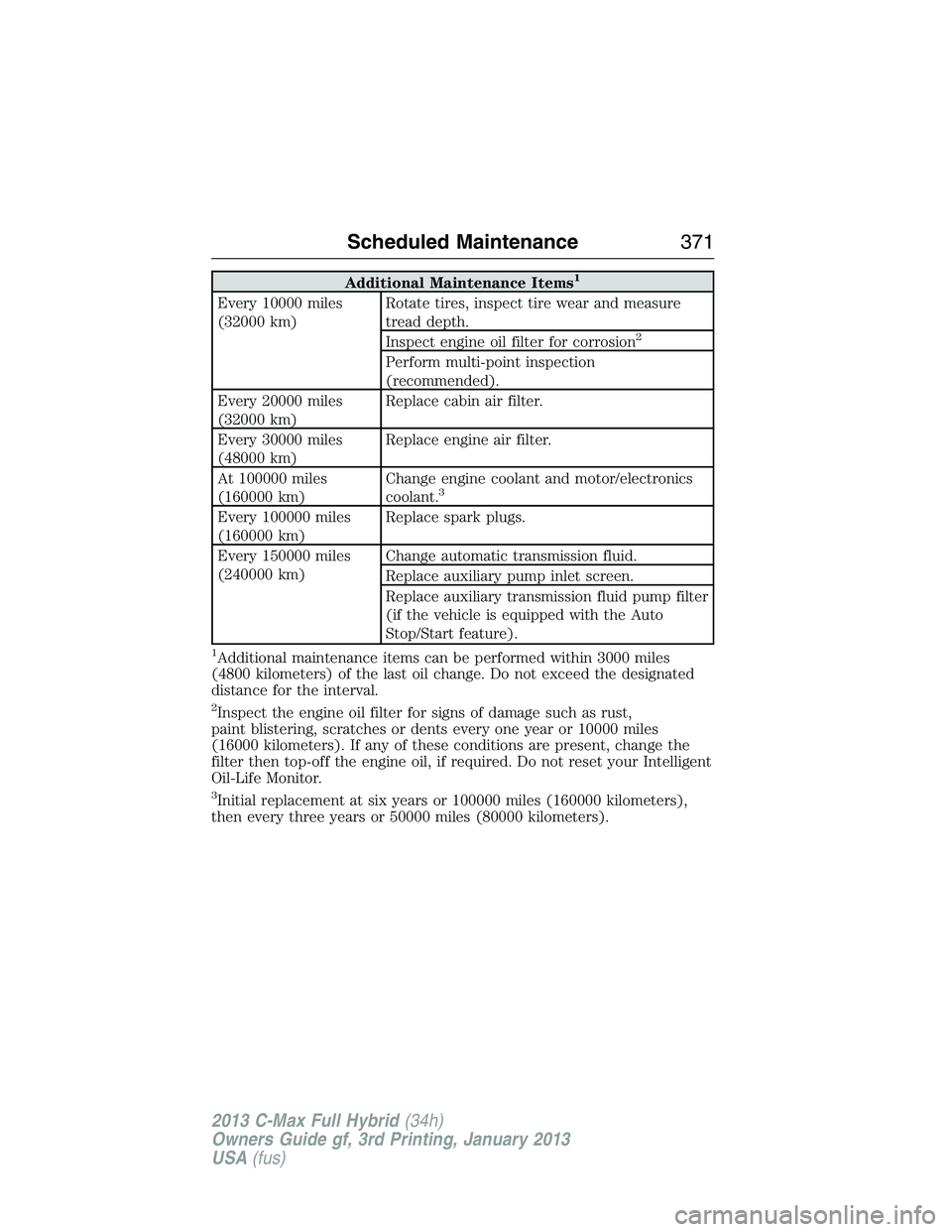
Additional Maintenance Items1
Every 10000 miles
(32000 km)Rotate tires, inspect tire wear and measure
tread depth.
Inspect engine oil filter for corrosion
2
Perform multi-point inspection
(recommended).
Every 20000 miles
(32000 km)Replace cabin air filter.
Every 30000 miles
(48000 km)Replace engine air filter.
At 100000 miles
(160000 km)Change engine coolant and motor/electronics
coolant.
3
Every 100000 miles
(160000 km)Replace spark plugs.
Every 150000 miles
(240000 km)Change automatic transmission fluid.
Replace auxiliary pump inlet screen.
Replace auxiliary transmission fluid pump filter
(if the vehicle is equipped with the Auto
Stop/Start feature).
1Additional maintenance items can be performed within 3000 miles
(4800 kilometers) of the last oil change. Do not exceed the designated
distance for the interval.
2Inspect the engine oil filter for signs of damage such as rust,
paint blistering, scratches or dents every one year or 10000 miles
(16000 kilometers). If any of these conditions are present, change the
filter then top-off the engine oil, if required. Do not reset your Intelligent
Oil-Life Monitor.
3Initial replacement at six years or 100000 miles (160000 kilometers),
then every three years or 50000 miles (80000 kilometers).
Scheduled Maintenance371
2013 C-Max Full Hybrid(34h)
Owners Guide gf, 3rd Printing, January 2013
USA(fus)